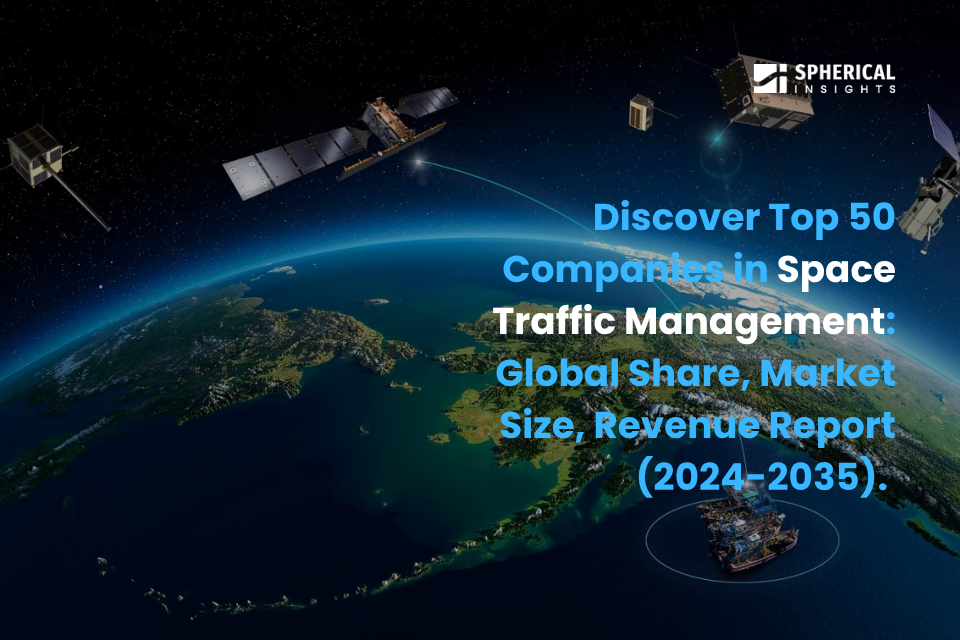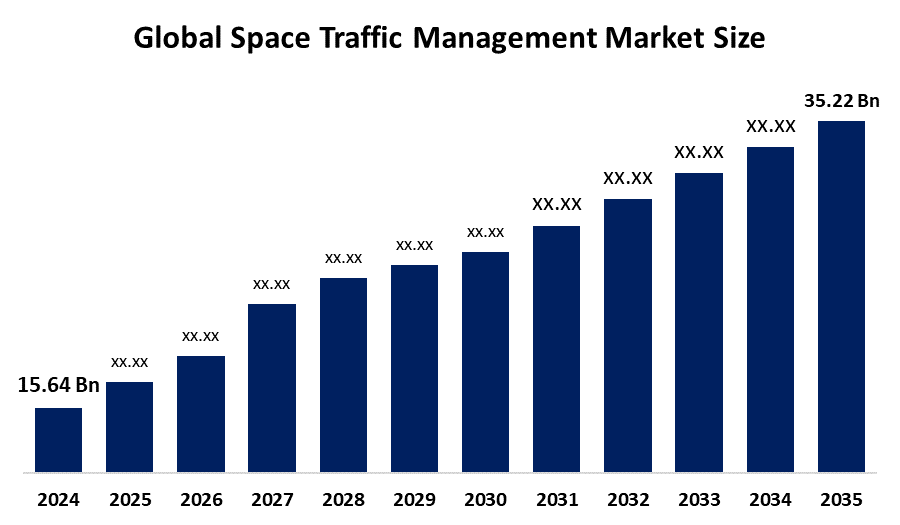
Discover Top 50 Companies in Space Traffic Management: Global Share, Market Size, Revenue Report (2024-2035)
RELEASE DATE: Jul 2025 Author: Spherical InsightsRequest Free Sample Speak to Analyst
Description
According to a research report published by Spherical Insights & Consulting, The Global Space Traffic Management Market Size is projected to grow from USD 15.64 Billion in 2024 to USD 35.22 Billion by 2035, at a CAGR of 7.66 % during the forecast period 2025–2035. The increasing number of satellites and constellations, the growth of space exploration activities, and the rising demand for satellite-based services.
Introduction
The operation of tracking the travel of spacecraft and other objects to avert collisions and human life and property is referred to as space traffic management. Space traffic management consists of practices, rules, and guidelines applied to conduct space activities safely, sustainably, and securely. Space traffic management (STM) is perhaps one of the strongest developments of space politics of its era. Space has itself been described as "contested, congested, and competitive." The need for greater safety and efficiency in the use of satellites and other space assets is the driving force behind the increasing demand for space traffic management. Automated systems can be extremely useful in each of these roles, and it is expected that their use will increase over the forecast period.
Navigate Future Markets with Confidence: Insights from Spherical Insights LLP
The insights presented in this blog are derived from comprehensive market research conducted by Spherical Insights LLP, a trusted advisory partner to leading global enterprises. Backed by in-depth data analysis, expert forecasting, and industry-specific intelligence, our reports empower decision-makers to identify strategic growth opportunities in fast-evolving sectors. Clients seeking detailed market segmentation, competitive landscapes, regional outlooks, and future investment trends will find immense value in the full report. By leveraging our research, businesses can make informed decisions, gain a competitive edge, and stay ahead in the transition toward sustainable and profitable solutions.
Unlock exclusive market insights - Download the Brochure now and dive deeper into the future of the Space Traffic Management Market.
Space Traffic Management Market Size & Statistics
- The Market for Space Traffic Management was estimated to be worth USD 15.64 Billion in 2024.
- The market is Going to expand at a CAGR of 7.66 % between 2025 and 2035.
- The Global Space Traffic Management Market Size is anticipated to reach USD 35.22 Billion by 2035.
- North America is expected to generate the highest demand during the forecast period in the Space Traffic Management market.
- Asia Pacific is expected to grow the fastest during the forecast period in the Space Traffic Management market.

Regional growth and demand
Asia Pacific is expected to grow the fastest during the forecast period in the Space Traffic Management market. Asia-Pacific region, China invests heavily in space activities. Space traffic management will also be improved by China, and its debris tracking system will be enhanced. China is a significant player in the Asia-Pacific Space Traffic Management market since it leads in space exploration. Efficient management systems are needed owing to the country's aggressive space program and increasing number of satellite launches.
North America is expected to generate the highest demand during the forecast period in the Space Traffic Management market. North America is the present market share leader in the global market for space traffic management. Leadership is spearheaded by the United States, possessing the most sophisticated space infrastructure, the largest number of satellites in operation, and advanced government and private space programs. NASA, the U.S. Department of Defense, and the Office of Space Commerce are all directly engaged in the development of STM, like initiatives like the Traffic Coordination System for Space (TraCSS) that will soon replace outdated, antiquated systems like the Space-Track platform.
Top 10 Space Traffic Management Trends
- Explosion of Satellite Constellations
- Rise of Artificial Intelligence and Machine Learning
- Development of Advanced SSA Sensors
- Growth in Automated Collision Avoidance Tools
- Regulatory Advancements and Policy Initiatives
- Strategic Partnerships and Market Consolidation
- Expansion Beyond LEO to MEO and GEO
- Integration with Air Traffic Management (ATM)
- Commercialization of STM-as-a-Service
- Push for International Collaboration and Data Sharing
1. Explosion of Satellite Constellations
The quick launch of satellite constellations, particularly in low Earth orbit (LEO), has unequivocally driven the demand for space traffic management. SpaceX, Amazon, and OneWeb are launching thousands of satellites into space that populate the orbital environment with high density and necessitate fine-grained coordination and live monitoring. This growth has created more collision hazards, and the demand for strong STM systems to prevent space congestion and debris accumulation.
2. Rise of Artificial Intelligence and Machine Learning
The quick launch of satellite constellations, particularly in the low Earth orbit (LEO), has unequivocally driven the demand for space traffic management. SpaceX, Amazon, and OneWeb are launching thousands of satellites into space that populate the orbital environment with high density and necessitate fine-grained coordination and live monitoring. This growth has created more collision hazards and the demand for strong STM systems to prevent space congestion and debris accumulation.
3. Development of Advanced SSA Sensors
There is expanding demand for Space Situational Awareness (SSA) that is prompting investment in very precise sensors like phased-array radars, optical ground-based telescopes, and space-based tracking systems. These provide continuous tracking of objects in space with more rapid response times to detected threats. Nations and private enterprise are creating global sensor networks to provide broader, real-time visibility around the orbit.
4. Growth in Automated Collision Avoidance Tools
As near-misses and close calls accumulate, satellite operators are turning to automated systems for collision detection and avoidance. These platforms monitor orbital data to suggest or even take pre-programmed responses. The objective is to move beyond the need for human reaction and create autonomous systems that prevent accidents without delay.
5. Regulatory Advancements and Policy Initiatives
Governments and international organizations are developing regulatory frameworks for STM. In the United States, standards development is underway for the Traffic Coordination System for Space (TraCSS) by the Office of Space Commerce, and the European Union is developing its own STM strategy. The efforts aim at standardization of data exchange, enhancing debris mitigation procedures, and developing enforceable guidelines for satellite operators internationally.
Empower your strategic planning:
Stay informed with the latest industry insights and market trends to identify new opportunities and drive growth in the space traffic management market. To explore more in-depth trends, insights, and forecasts, please refer to our detailed report.
Top 10 Companies Leading the Space Traffic Management Market
- Space Machines Company
- Ananth Technologies
- Digantara
- Neuraspace
- Lockheed Martin
- Saab AB,
- Northrop Grumman
- Raytheon Technologies
- BAE Systems plc
- Thales Group
1. Space Machines Company
Headquarters – Australia
Space Machines Company is a new Australian firm specializing in in-orbit transportation and servicing. It is also involved in SSA and space traffic coordination technology, particularly in the Indo-Pacific. It is going to assist STM with onboard systems that track nearby orbital activity in real time.
2. Ananth Technologies
Headquarters – India
Ananth Technologies is a prominent Indian aerospace company collaborating with ISRO and private satellite companies. It is making an entry into STM space through satellite integration, launch services, and orbital safety solutions. With the opening up of India's space industry to private capital, Ananth will address domestic STM demand by providing data and tracking facilities.
3. Neuraspace
Headquarters – Portugal
Neuraspace provides AI-driven STM solutions that identify orbital hazard and assist satellite operators in avoiding collision. Headquartered in Portugal, the company employs machine learning to track thousands of satellites and objects of space junk. Its cloud-native architecture is being used extensively in Europe and acquiring traction with commercial constellation operators.
4. Lockheed Martin
Headquarters – USA
Lockheed Martin, a multinational defense and aerospace corporation, has a significant contribution to STM business through its operations in SSA systems for allied nations and the US military. The corporation produces space surveillance radars, satellite tracking software, and coordination platforms used to enhance space security and traffic monitoring.
5. Saab AB
Headquarters – Sweden
Saab AB contributes to STM in the form of radar systems, defense communication networks, and ground stations for satellites. Saab provides support for government and commercial space safety and orbital surveillance operations, mainly in Europe and the Nordic countries.
Are you ready to discover more about the Space Traffic Management market?
The report provides an in-depth analysis of the leading companies operating in the global space traffic management market. It includes a comparative assessment based on their product portfolios, business overviews, geographical footprint, strategic initiatives, market segment share, and SWOT analysis. Each company is profiled using a standardized format that includes:
Company Profiles
- Space Machines Company
- Business Overview
- Company Snapshot
- Products Overview
- Company Market Share Analysis
- Company Coverage Portfolio
- Financial Analysis
- Recent Developments
- Merger and Acquisitions
- SWOT Analysis
- Ananth Technologies
- Digantara
- Neuraspace
- Lockheed Martin
- Saab AB,
- Northrop Grumman
- Raytheon Technologies
- BAE Systems plc
- Thales Group
Conclusion
The world space traffic management (STM) market is rapidly becoming a core pillar of space infrastructure, with a vision to continually increase satellite traffic safe, coordinated, and sustainable. With increasing satellite constellations and more countries taking part in the space race, precise tracking, real-time collision prevention, and succinct regulatory frameworks are more pressing than ever. North America dominates with robust technical competence and policy support, followed by Asia-Pacific with rapid adoption driven by increasing satellite launches and indigenous innovation. Giving topmost priority to trends like AI-pushed monitoring, automated avoidance systems, and STM-as-a-service models are revolutionizing space management.
About the Spherical Insights & Consulting
Spherical Insights & Consulting is a market research and consulting firm which provides actionable market research study, quantitative forecasting and trends analysis provides forward-looking insight especially designed for decision makers and aids ROI.
Which is catering to different industry such as financial sectors, industrial sectors, government organizations, universities, non-profits and corporations. The company's mission is to work with businesses to achieve business objectives and maintain strategic improvements.
CONTACT US:
For More Information on Your Target Market, Please Contact Us Below:
Phone: +1 303 800 4326 (the U.S.)
Phone: +91 90289 24100 (APAC)
Email: inquiry@sphericalinsights.com, sales@sphericalinsights.com
Contact Us: https://www.sphericalinsights.com/contact-us
Need help to buy this report?